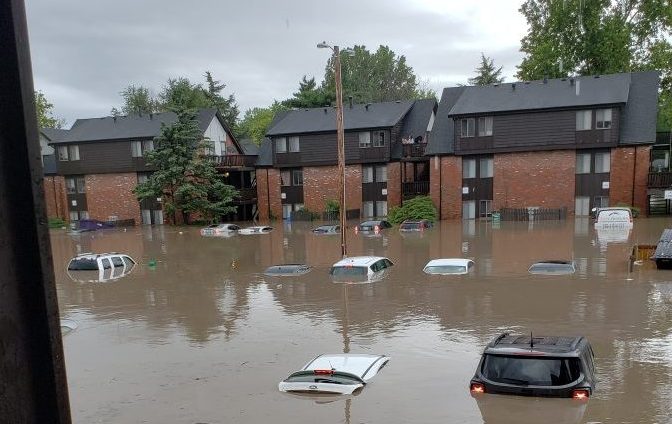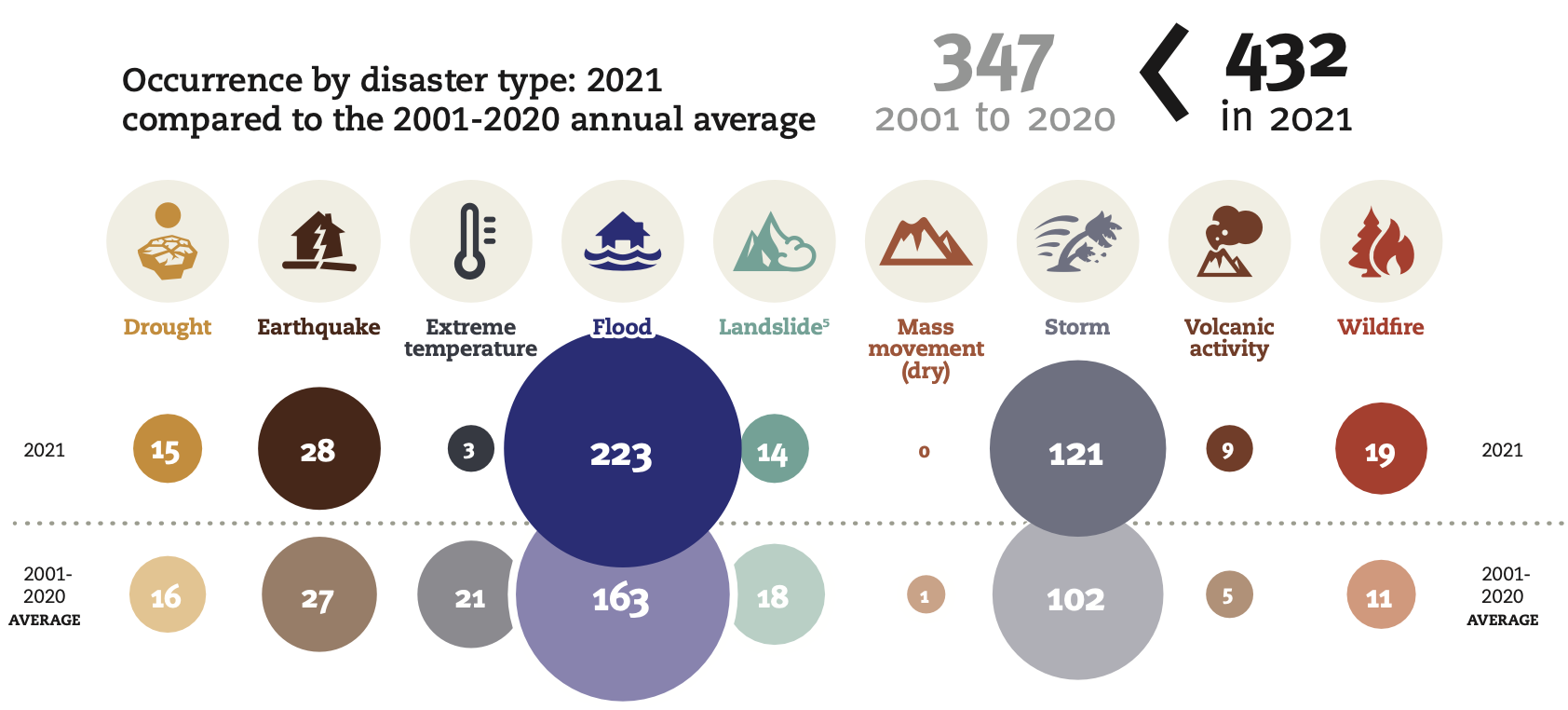
Floods
Flooding is our nation’s most common natural disaster. Regardless of whether a lake, river or ocean is actually in view, everyone is at some risk of flooding. Flash floods, tropical storms, increased urbanization and the failing of infrastructure such as dams and levees all play a part — and cause millions (sometimes billions) of dollars in damage across the U.S. each year.
Overview
Regardless of whether a lake, river or ocean is in view, everyone is at some risk of flooding. Flash floods, tropical storms, increased urbanization and the failing of infrastructure such as dams and levees all play a part — and cause billions of dollars in damages and economic losses globally each year.
According to the United States Geological Survey (USGS), “Flooding occurs in known floodplains when prolonged rainfall over several days, intense rainfall over a short period of time, or a debris jam causes a river or stream to overflow and flood the surrounding area.”
In the U.S., flooding is the most common and costly disaster, affecting homes, businesses, infrastructure and the environment. According to the Pew Charitable Trusts, “Since 2000, flood-related disasters in the U.S. accounted for more than $850 billion in damage and losses.”
The same is true globally. According to the Centre for Research on the Epidemiology of Disasters (CRED), “In 2021, a total of 432 catastrophic events were recorded, which is considerably higher than the average of 357 annual catastrophic events for 2001-2020. Floods dominated these events, with 223 occurrences, up from an average of 163 annual flood occurrences recorded across the 2001-2020 period.”

Floods can also be deadly. Of the five deadliest disasters globally in 2021, two were from floods. During India’s 2021 monsoon season, India experienced a series of floods that claimed 1,282 lives. In July 2021, floods in the Chinese province of Henan resulted in 352 deaths, with 14.5 million people affected. Henan is a landlocked province and its capital, Zhengzhou, received a year’s average rainfall in just three days, demonstrating that devastating floods occur inland and not only in coastal areas.
Water-related hazards are increasing in frequency. According to the World Meteorological Organization (WMO), “Since 2000, flood-related disasters have increased by 134%.” Extreme events, including catastrophic floods, are expected to increase in frequency and severity in the coming decades. More significant investment in preparedness and adaptation will be needed.
Progress has been made in recent years to improve flood policies in the U.S. For example, in 2021, the Federal Emergency Management Agency (FEMA) announced a new rate-setting methodology for federally backed flood insurance policies that aligns National Flood Insurance Program (NFIP) rates more closely to risk, makes rates fairer and factors in climate change.
Key Facts
- Flooding is a concern inland in addition to coastal areas. Landfalling coastal storms and brief periods of intense precipitation can lead to inland flooding. A changing climate contributes to increasing inland flood risk. Climate change has hit Iowa almost as hard as Palm Beach. Examples from other U.S. states including Tennessee, Massachusetts and North Carolina demonstrate the prevalence of inland flood risk.
- Flooding conditions are heavily affected by the existing state of the ground. Snowmelt, for example, can cause flooding when the ground is too frozen to absorb water. Difficulties with absorption also follow drought, often leading to flash flooding because of over-parched ground and debris in drainage systems.
- Urban development increases the number of impenetrable areas. According to the USGS, construction and new development affect natural drainage. With roads and parking lots, runoff in urban areas could be two to six times over what would occur on natural terrain. In addition, population growth near dams and levees can mean increased risk exposure.
- Flood risk may be disproportionately higher for some marginalized and racial communities. Research has demonstrated that where people live is the most important factor for overall flood risk. According to a study published in January 2022, “flood risk in the U.S. will increase by about 25% in the next three decades, and Black communities in the South will face disproportionate harm.” Previous analyses have found that the disproportionate impact of flooding on Black Americans is not only in our future; it is already a reality.
- Floods often exacerbate complex humanitarian emergencies (CHE). In May 2022, severe rainfall in Afghanistan led to flash flooding affecting at least 485 families. In the first four months of 2022, more than 5,000 Afghans were affected by flash flooding. Considering the frequency of flooding events compared to other disaster types, it is likely that floods will continue to affect countries and regions where a CHE is ongoing. Flood preparedness and recovery may look different in these contexts.
How to Help
- Support initiatives that raise awareness. Examples include what to do in the event of an evacuation and sharing information about the danger of driving in flooded waters.
- Help fill gaps between insurance payouts and actual costs for those in affected communities. Most homeowners insurance does not protect against flooding, and flood insurance may not cover all costs incurred.
- Support community-based organizations already working in disaster-affected communities. Whether nationally or internationally, seek out the organizations with long-standing relationships in place. Also, look for those who understand unique cultural, geographical and operational differences.
- Fund remediation of mold in disaster-affected areas. Mold continues to be a widespread concern even years after a flood.
- Invest in climate resilience and adaptation planning. Planning efforts are often reactive instead of proactive. Strengthening planning at the national, state and local levels can save lives and money.
- Supply evacuation “go kits” for populations living in areas that are at high risk of flooding. These kits might include batteries, hand-crank weather radios, flashlights, personal hygiene items, first aid supplies, a three-day supply of food and water, clothes, rain gear and other useful supplies.
What Funders Are Doing
- The Center for Disaster Philanthropy (CDP), through its Midwest Early Recovery Fund, awarded $140,448 to the White Swan Community Long-Term Recovery Group (fiscal sponsor Tree of Life Ministry) in 2021 to improve living conditions after flooding on the Yankton Sioux Reservation in South Dakota. The grant supported the group’s activities, including community recovery coordination, local disaster case management, mold remediation and food distribution.
- CDP awarded $100,000 to the Malaysian Medical Relief Society in 2022 to support and empower communities affected by December 2021 floods in Selangor, Malaysia. Activities included rebuilding community infrastructure and strengthening the capacity of local communities for preparedness and mitigation.
- CDP, through its Global Recovery Fund, awarded $433,327 to Support to Life in 2021 to support wildfire and flood-affected communities by restoring livelihoods and enhancing disaster preparedness and response capacities for future disasters through the provision of micro cash grants and strengthening local groups using the Survivor and Community-Led Response approach.
- Oberweiler Foundation awarded $25,000 to Environmental Law & Policy Center in 2020 to help make the Lake Michigan shoreline in the U.S. resilient to flooding risks by analyzing specific high flood risk areas and raising awareness of flooding challenges with policymakers.
- American Jewish World Service awarded $6,512 to Kampuchea Women’s Welfare Action in 2020 to support relief and disaster risk reduction efforts for farming communities affected by flooding in Kratie province, Cambodia, through the distribution of animal feed and training on sustainable farming and climate change adaptation.
Learn More
- National Flood Insurance Program (NFIP)
- State Resilience Partnership
- The Pew Charitable Trusts – Flood Prepared Communities Project
- Association of State Floodplain Managers
- USGS – Floods: Things to Know
- FEMA – Historical Flood Costs and Risks
- UN Water – Water and Disasters
- UNESCO – Water-Related Disasters
- UN University’s Institute for Water, Environment and Health – Flood Mapping Tool
We welcome the republication of our content. Please credit the Center for Disaster Philanthropy.